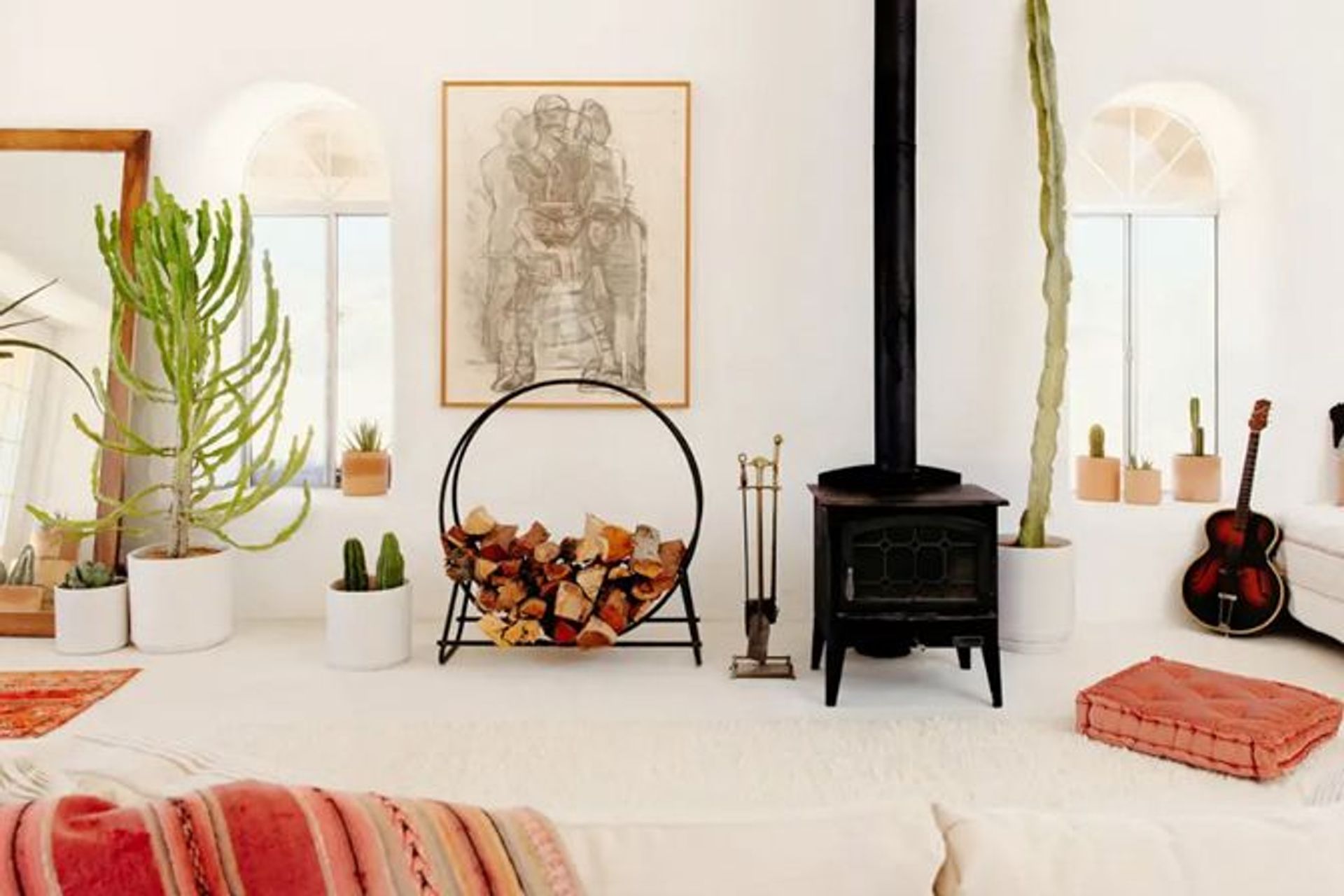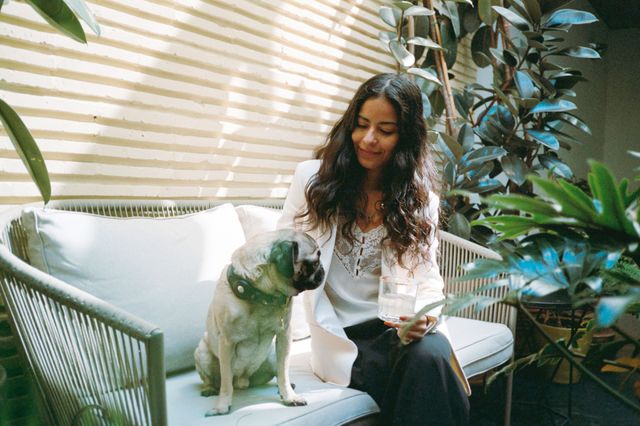A Conversation with Bryan Crawford of Sueno Sagrado
- Category
- Q&A
- Written by
- Charlotte Beach
- Published
- May 30, 2019

Sueno Sagrado in the Mojave enclave of Pioneertown, California, is owned and operated by Bryan Crawford, a Missouri-born jack of all trades now based in Los Angeles. His road to Pioneertown has been anything but direct, as a former music journalist who’s even dabbled in furniture design (a desk he built is now staged in the garage at Sueno Sagrado, where you’ll also find an outdoor couch).
While exploring the LA furniture design community, Bryan met Stephen Kenn, a prolific designer whose pieces are featured at Spronken House in Spain. When Stephen heard that Bryan had a special spot in Pioneertown for rent, he knew to send him our way.
And we’re so glad that he did. Bryan and his business partners Jeff and Kristin have made Sueno Sagrado a serene escape folded into the wild landscape of the California desert. We recently sat down with Bryan to learn more about the property.

HOW DID SUENO SAGRADO COME INTO YOUR LIFE?
Bryan Crawford: “There was a family of olive farmers from the Basque region of Spain that had bought this 44 acres and had built this straw bale home. But they were getting on in years and wanted to go home and be with their family, so they sold it to me and my business partners.”
WHAT SORT OF CHANGES DID YOU MAKE TO THE HOUSE ONCE YOU BOUGHT IT?
BC: “Immediately we knew we had to redesign the home, update it a little bit. It was very much like a ranch home with Albuquerque vibes. A lot of the sunburst tile in and out, a drop ceiling in the bathroom, and a little pantry alcove. So we updated the kitchen and opened it up, and there was no partition for the bedroom. So we built one so that there were closable doors to the bedroom–not that anybody’s sleeping in! But there’s a lot of serenity in that space, so to be able to provide just a tiny bit of that in the bedroom is important.”
WHERE DID THE NAME SUENO SAGRADO (SACRED DREAM) COME FROM?
BC: “Honestly, just the idea of having the best sleep that you’ve had in recent memory. After spending time there and getting totally whooped from a day’s work and falling asleep right when the sun goes down, and waking up in the middle of the night just to take a peak at the stars, then falling back asleep and waking up again when the sun rises. Having that experience over and over and over again, I was sleeping so odd, but I was catching all of those magical moments of the night; the sunset, stars out, sunrise. And I was kind of invigorated by the natural beauty of those things. It evoked a real sense of importance in that restorative sleep. It felt sacred, in a way.”

WHY WERE YOU DRAWN TO THE DESERT?
Bryan Crawford: “The desert is really having a ‘moment’ — and I say that because of the corniness of that phrase. I’ve been going out there for as long as I’ve been in LA, which has been about nine years. And the numbers are staggering. I think the number of people last year visiting Joshua Tree was something like two million. So, when the opportunity came up to have this space that was kind of its own little piece of the desert, also sort of away from all of the other pieces of desert, we took it. It really felt like it wasn’t even ours, it felt like it was the desert’s. It’s sitting on the corner of BLM (Bureau of Land Management) land at the foot of the Black Lava Butte which is an indigenous holy land and that’s why it became a national monument. So there’s a significance to that view, and we have a lot of respect for that.”
HOW IS HAVING A HOUSE IN THE DESERT DIFFERENT FROM OTHER ENVIRONMENTS?
BC: “Everything that we do requires infrastructure that disrupts the natural environment. So we always, always are trying to be mindful of what we’re doing. The impermanent and disruptive nature of that, and how we can minimize the impact to the environment. The house is 100% solar, off-grid. With everything that we do there, we’re trying to make it contextually sensitive. It’s such a singular place–there’s no place like the Mojave. So we’re always trying to lead with that mindset.”
CAN YOU TELL US ABOUT THE WALL GARDEN?
BC: “The wall garden is super significant in oral tradition. I had just finished reading a version of the wall garden story, and the allegory there is that whatever you get out of recognition from the work that you do to the garden goes back into the garden. So when I found that that structure was there–and at the time it had these old trusses and it was kind of overgrown–in a super irrational, totally emotional way, I was like, ‘This is very significant!’ Because that story of work reciprocity really resonates with me. And also the silliness of trying to grow things in the desert I think is fun.”


HOW DID YOU BRING THE WALL TO LIFE?
Bryan Crawford: “I have a friend who works for the Mojave Desert Land Trust and is a landscape architect down in the desert, and I’ve been working with her to identify what has the highest probability of actually growing out there.
"So we did a test, starting in September of last year. We planted a number of agave, native and non-native cacti in a very responsible way, and we said to ourselves, let’s see what makes it through what wound up being a very cold, hard winter. There were feet of snow, there was the most snow that anyone had seen in 40 years. And we came back, and some of those agave are still alive! Some of the cacti, sadly, are not.
"So we’re getting a better idea of what it would look like to try to grow things out there. There are olive trees from the previous owners, and there are also some grapevines that have been growing out there natively–desert wine is a thing! We’re trying to be observant, not be overly-confident that we can walk in the desert and grow things where things haven’t grown in maybe thousands of years. And just trying to do less and see what comes of it.”

WHAT SORTS OF PEOPLE STAY AT SUENO SAGRADO?
Bryan Crawford: “We’ve had such good luck, and maybe it’s in the way we set expectations. We say the house is off-grid, there’s nothing nearby whatsoever. Overall we’ve had very respectful people. People don’t go out there to party and cut loose. They go out there to look inward and quiet themselves, and I feel like people really achieve that. They receive a lot of that quiet that they’re looking for. It is astoundingly quiet. And it’s increasingly hard to find that.
"So I think because of the unique nature of the experience, it has a profound effect on people. We’ve been really fortunate to have such a mindful audience.”
WHAT’S PIONEERTOWN LIKE?
BC: “It has this sort of kitschy history. People drive through slowly, gawking, not really knowing what they’re looking at because it is a bit odd and from a bygone era. It’s kind of a creative community in the middle of the desert too. The desert’s creative community is a lot like desert wildlife: you don’t see it, but it’s deceptively there.”



WHAT’S NEXT FOR SUENO SAGRADO?
BC: “We want to have a water feature out there this summer, which we’re kind of figuring out how to best develop. Turns out it’s really hard to heat water and not really wise from a green energy perspective, so hot tubs aren’t a great idea. So I think we want to do a cold water feature. Obviously it gets very, very cold there since it’s at 5,000-foot elevation. We want to do something that’s near the home, as well as something that’s a little bit of a destination, maybe something that you have to hike to.”
To book a stay at Sueno Sagrado, click here.

